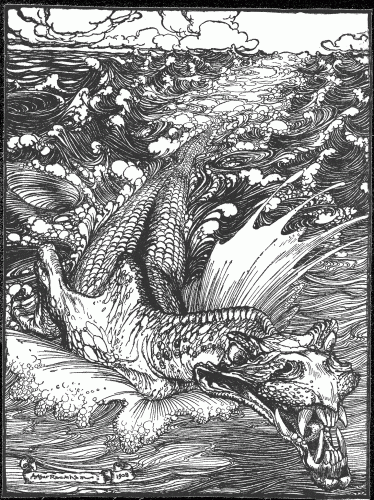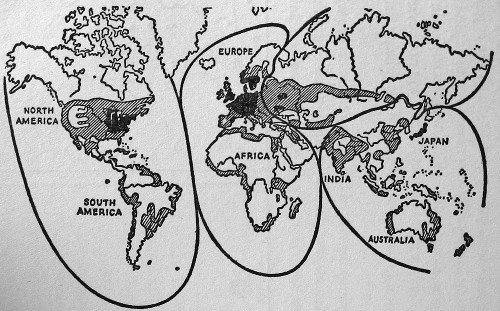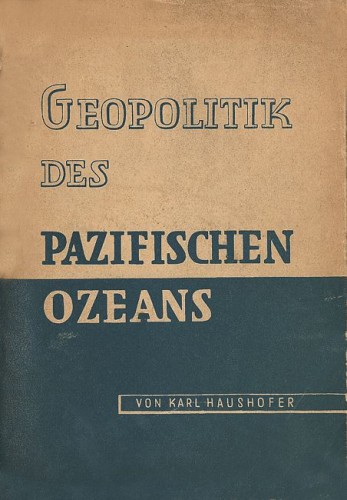mercredi, 24 août 2011
Geopolitics of Leviathan

Geopolitics of Leviathan
By Edouard RIX
Ex: http://www.counter-currents.com/
Translated by Greg Johnson
“Nur Meer und Erde haben hier Gewicht.”
(Only sea and land matter here.)
—Goethe
This article is less concerned with geopolitics than with thalassopolitics, a neologism coined by professor Julien Freund “to call into question certain conceptions of geopolitics that privilege telluric phenomena over maritime phenomena.”
“World history is the history of the fight of maritime powers against continental powers and of continental powers against maritime powers” writes Carl Schmitt in Land and Sea.
In the Middle Ages, the cabbalists interpreted the history of the world as a combat between the powerful whale, Leviathan, and the no less powerful Behemoth, a land animal imagined as looking like an elephant or a bull. Behemoth tries to tear Leviathan with its defenses, its horns or its teeth, while Leviathan, for its part, tries to stop with its fins the mouth and the nose of the land animal to starve or suffocate it. A mythological allegory not unrelated to the blockade of a terrestrial power by a maritime power.
The “Sea Power” of Admiral Mahan
Around the turn of the 20th century, the American Alfred T. Mahan in The Influence of Sea Power upon History (1890), the German Friedrich Ratzel in Das Meer als quelle der Volkergrösse [The Sea as Source of National Greatness] (1900), and the British Halford John Mackinder in Britain and the British Seas (1902), attach a paramount importance to the sea as source of power of the nations.
Admiral, historian, and professor at the US Naval Academy, Alfred T. Mahan (1840–1914) is the most famous geopolitician of the sea, his work comprising twenty books and 137 articles. On the basis of the study of European History of the 17th and 18th centuries, he sought to show how maritime power (Sea Power) appeared determinative of the growth and prosperity of nations.
For him, the sea can act against the land, whereas the reverse is not true and, in the long run, the sea always ends up winning any fight against the land. Mahan is deeply persuaded that the control of the seas ensures the domination of the land, which he summarizes with the formula “the Empire of the sea is without any doubt the Empire of the world.” By thus affirming the intrinsic superiority of the maritime empires, he offers a theoretical justification to imperialism, the great expansionist movement of the years 1880–1914.
In The Problem of Asia, published in 1900, Mahan applies his geopolitical paradigm to Asia, insisting on the need for a coalition of maritime powers to contain the progression towards the open sea of the great terrestrial power of the time, Russia. Indeed, he stresses that its central position confers a great strategic advantage on the Russian Empire, because it can extend in all directions, and its internal lines cannot be crossed.
On the other hand—and here lies its principal weakness—its access to the sea is limited, Mahan seeing only three possible axes of expansion: toward Europe, to circumvent the Turkish blockade of the straits, toward the Persian Gulf, and toward the China Sea. This is why the admiral recommends damming up the Russian tellurocracy through the creation of a vast alliance of the maritime powers, thalassocracies, which would include the United States, Great Britain, Germany, and Japan, the Americans asserting themselves as the leaders of this new Holy Alliance.
Halford John Mackinder
Inspired by Admiral Mahan, the British academic Halford John Mackinder (1861–1947) also believed that the fundamental geopolitical reality is the opposition between continental powers and maritime powers. A fundamental idea run throughout his work: the permanent confrontation between the Heartland, i.e. the central-Asian steppe, and the World Island, the continental mass Asia-Africa-Europe.
In 1887, Mackinder delivered a short public speech to the Royal Geographical Society that marked his resounding debut on the geopolitical stage, declaring in particular “there are two types of conquerors today: land wolves and sea wolves.” Behind this allegorical and somewhat enigmatic utterance is the concrete reality of Anglo-Russian competition in Central Asia. In fact, Mackinder was obsessed by the safety of the British Empire vis-à-vis the rise of Germany and Russia. In 1902, in Britain and the British Seas, he noted the decline of Great Britain and concluded from it that she must “divide the burden” with the United States, which would take over sooner or later.
In his famous essay of 1904, “The Geographical Pivot of History,” he formulates his geopolitical theory. One can summarize it in two principal points: (1) Russia occupies the pivotal zone inaccessible to maritime power, from which it can undertake to conquer and control the Eurasian continental mass, (2) against Russia, maritime power, starting from its bastions (Great Britain, the United States, South Africa, Australia, and Japan) that are inaccessible to terrestrial power, encircles the latter and prohibits her from freely reaching the open sea.
Studying the “pre-Colombian” epoch, Mackinder contrasted the Slavs, who inhabited the forests, with the nomadic riders of the steppes. This semi-desert Asian steppe is the Heartland, surrounded by two densely populated crescents: the inner crescent, encompassing India, China, Japan, and Europe, which are territorially adjacent to the Heartland, and the outer crescent, made up of various islands. The inner crescent is regularly subject to the pressures of nomadic horsemen from the steppes of the Heartland.
Everything changed in the “Colombian” age, which saw the confrontation of two mobilities, that of England which began the conquest of the seas, and that of Russia which advanced gradually in Siberia. For the academic Mackinder, this double European expansion, maritime and continental, found its explanation in the opposition between Rome and Greece. Indeed, he affirms that the Germans were civilized and Christianized by the Roman, the Slavs by the Greeks, and that whereas the Romano-Germans conquered the oceans, the Slavs seized the steppes on horseback.
Mackinder made the separation between Byzantine and Western Empires in 395, exacerbated by the Great Schism between Byzantium and Rome in 1054, the nodal point of this opposition. He emphasized that after the fall of Constantinople to the Turks, Moscow proclaimed itself the new center of Orthodoxy (the Third Rome). According to him, in the 20th century, this religious antagonism will lead to an ideological antagonism, between Communism and capitalism: Russia, heiress of the Slavic country village community, the Mir, will choose Communism, the West, whose religious practice privileges individual salvation, for capitalism . . .
For Mackinder, the opposition Land/Sea is likely to lean in favor of the land and Russia. Mackinder noted that if the United Kingdom could send an army of 500,000 to South Africa at the time of the Boer Wars, a performance saluted by all the partisans of the maritime power, Russia at the same time had succeeded in an even more exceptional exploit by maintaining an equivalent number of soldiers in the Far East, thousands of kilometers of Moscow, thanks to the Trans-Siberian Railroad. With the railroad, the terrestrial power was henceforth able to deploy its forces as quickly as the oceanic power.
Enthralled by this revolution in land transportation, which would make it possible for Russia to develop an industrialized space that is autonomous from and closed to trade with the thalassocracies, Mackinder predicted the end of the “Colombian” age and concluded that the telluric power is superior, summarizing his thought in a striking aphorism: “Whoever holds continental Europe controls the Heartland. Whoever holds the Heartland controls the World Island.”
Indeed, any economic autonomy in central-Asian space leads automatically to a reorganization of the flow of trade, the inner crescent thus having an interest in developing its commercial relations with the center, the Heartland, to the detriment of the Anglo-Saxon thalassocracies. A few years later, in 1928, Stalin’s announcement of the implementation of the first Five Year Plan would reinforce the British thinker, who did not fail to stress that since the October Revolution, the Soviets built more than 70,000 kilometers of railways.
Shortly after the First World War, Mackinder published Democratic Ideals and Reality, a concise and dense work in which he recalls the importance of the Russian continental mass, that the thalassocracies can neither control from the seas nor invade completely. Thus, concretely, it is imperative to separate Germany from Russia by a “cordon sanitaire,” in order to prevent the union of the Eurasiatic continent. This prophylactic policy was pursued by Lord Curzon, who named Mackinder High Commissioner in “South Russia,” where a military mission assisted the White partisans of Anton Denikin and obtained from them the de facto recognition of the new Republic of Ukraine . . .
To make impossible the unification of Eurasia, Mackinder never ceased recommending the balkanization of Eastern Europe, the amputation from Russia of its Baltic and Ukrainian glacis, the “containment” of Russian forces in Asia so that they could not threaten Persia or India.
Notes
1. C. Schmitt, Terre et Mer (Paris: Le Labyrinthe, 1985), p. 23. [See the English translation available on this website here [2]. -- Trans.]
2. The names of Leviathan and Behemoth are borrowed from the Book of Job (chapters 40 and 41).
3. A. T. Mahan, The Problem of Asia and its Effect upon International Policies (London: Sampson Low-Marston, 1900), p. 63.
Source: Edouard Rix, Terre & Peuple, No. 46 (Winter Solstice 2010), pp. 39–41.
Online: http://tpprovence.wordpress.com/2011/07/07/geopolitique-du-leviathan/ [3]
Geopolitics of Leviathan, Part 2
Karl Haushofer’s Kontinentalblock

It was in Germany, under the decisive influence of Karl Haushofer (1869–1946), that geopoliticians, diplomats, and National Revolutionary and National Bolshevik theorists (the Jünger brothers, Ernst Niekisch, Karl-Otto Paetel) would oppose thalassocratic pretentions with greatest force.
A Bavarian artillery officer and professor at the War Academy, Karl Haushofer was sent to Japan in 1906 to reorganize the Imperial Army. During his return to Germany on the Trans-Siberian railroad, he became vividly aware of the continental vastness of Russian Eurasia. After the First World War, he earned a doctorate and became professor of geography in Munich, where connected with Rudolf Hess. In 1924, Haushofer founded the famous Zeitschrift für Geopolitik (Journal of Geopolitics). He was the direct intellectual heir to his compatriot Friedrich Ratzel and the Swede Rudolf Kjeller.
To begin, let us set aside the black legend of Haushofer as fanatical Hitlerist who used geopolitics to justify the territorial conquests of the Third Reich, a legend based in “American propaganda efforts,” according to Professor Jean Klein.[1] This diabolization will astonish only those who are ignorant of the anti-thalassocratic orientation of Haushofer’s geopolitics . . .

Haushofer wished to rise above petty nationalisms. Thus, beginning in 1931, in Geopolitik der Pan-Ideen (Geopolitics of Continental Ideas), he advocated the constitution of vast continental spaces as the only means to go beyond the territorial and economic weakness of traditional States. The first stage could be the sub-continental gatherings theorized in 1912 by the geographer E. Banse, who recommended 12 large civilizational regions: Europe, Greater Siberia (Russia included), Australia, the East Indies, Eastern Asia, the “Nigritie” (the “black lands,” i.e., Africa), Mongolia (with China, Indochina, and Indonesia), Greater California, the Andes, America (Atlantic North America), and Amazonia.
 Haushofer’s radically continentalist and anti-thalassocratic thought came into focus in 1941, when he published Der Kontinentalblock-Mitteleuropa-Eurasien-Japan (The Continental Bloc Central Europe-Eurasia-Japan). Written after the Germano-Soviet pact, this work argued for a Germano-Italo-Soviet-Japanese alliance that would radically reorganize the Eurasian continental mass. He stressed that the permanent fear of the Anglo-Saxons is the emergence of a Berlin-Moscow-Tokyo axis, which would completely escape the influence of the commercial thalassocracies, which, he writes, practice the policy of the anaconda, which consists in gradually encircling and slowly suffocating its prey. But a unified Eurasia would be too large for the Anglo-American anaconda. Thanks to its gigantic mass, it could resist any blockade.
Haushofer’s radically continentalist and anti-thalassocratic thought came into focus in 1941, when he published Der Kontinentalblock-Mitteleuropa-Eurasien-Japan (The Continental Bloc Central Europe-Eurasia-Japan). Written after the Germano-Soviet pact, this work argued for a Germano-Italo-Soviet-Japanese alliance that would radically reorganize the Eurasian continental mass. He stressed that the permanent fear of the Anglo-Saxons is the emergence of a Berlin-Moscow-Tokyo axis, which would completely escape the influence of the commercial thalassocracies, which, he writes, practice the policy of the anaconda, which consists in gradually encircling and slowly suffocating its prey. But a unified Eurasia would be too large for the Anglo-American anaconda. Thanks to its gigantic mass, it could resist any blockade.
 The idea of a tripartite alliance first occurred to the Japanese and Russians. At the time of the Russo-Japanese War of 1905, when the British and Japanese united against the Russians, some of the Japanese leadership—including Hayashi, their ambassador in London, Count Gato, Prince Ito, and Prime Minister Katsura—desired a Germano-Russo-Japanese pact against the English seizure of global sea traffic. The visionary Count Gato recommended a troika in which the central horse, the strongest one, flanked by two lighter and more nervous horses, Germany and Japan. In Russia, the Eurasian idea would be incarnated a few years later by the minister Sergei Witte, the creative genius of the Trans-Siberian Railroad who in 1915 advocated a separate peace with the Kaiser.
The idea of a tripartite alliance first occurred to the Japanese and Russians. At the time of the Russo-Japanese War of 1905, when the British and Japanese united against the Russians, some of the Japanese leadership—including Hayashi, their ambassador in London, Count Gato, Prince Ito, and Prime Minister Katsura—desired a Germano-Russo-Japanese pact against the English seizure of global sea traffic. The visionary Count Gato recommended a troika in which the central horse, the strongest one, flanked by two lighter and more nervous horses, Germany and Japan. In Russia, the Eurasian idea would be incarnated a few years later by the minister Sergei Witte, the creative genius of the Trans-Siberian Railroad who in 1915 advocated a separate peace with the Kaiser.
Needless to say, Haushofer disapproved of Hitler’s wars of conquest in the East, which went against his historical project of creating a Eurasian continental bloc.
The Anaconda Strategy of Spykman and Brzezinski
The fundamental idea, posed by Mahan and Mackinder, to prohibit Russia’s access to the open sea, would be reformulated by Nicholas John Spykman (1893–1943), who insisted on the pressing need for controlling the maritime ring or Rimland, the littoral zone bordering the Heartland and which runs from Norway to Korea: “Whoever controls the maritime ring holds Eurasia; whoever holds Eurasia controls the destiny of the world.”[2]
Interpreting this maxim at that onset of the Cold War, the United States tried by a policy of “containment” of the USSR, to control the Rimland by means of a network of regional pacts: NATO in Europe, the Baghdad Pact then the Organization of the central treaty of the Middle East, SEATO and ANZUS in the Far East.
With the collapse of the Soviet bloc, one might have expected a strategic redeployment of the USA and a break with Mackinderite orthodoxy. But that was not to be. So much so that still today, the (semi-official) foreign policy adviser most heeded by President Obama proves to be a dedicated disciple of Mackinder: none other than Zbigniew Brzezinski, a friend of David Rockefeller, with whom he co-founded the Trilateral Commission in 1973, and Jimmy Carter’s National Security Advisor from 1977 to 1980. His major theoretical work, The Grand Chessboard, appeared in 1997, at the time of the wars in Yugoslavia undertaken mainly under his initiative, under the aegis of the Secretary of State Madeleine Albright.
Brzezinski’s strategic analysis cynically reprises Anglo-Saxon geopolitical doxa: Eurasia, which comprises half the planet’s population, constitutes the spatial center of world power. The key to control Eurasia is Central Asia. The key to control Central Asia is Uzbekistan. For this Russophobe of Polish origin, the objective of the American Grand Strategy must be to fight against a China-Russia alliance. Considering that the principal threat comes from Russia, he recommends its encirclement (the anaconda, always the anaconda) by the establishment of military bases, or, in the absence of friendly regimes in the former Soviet republics (Ukraine included), insisting in particular on the necessary utilization of Islamists. Paradoxically, it is in the name of the fight against these same Islamists that American forces were deployed Uzbekistan after September 11th, 2001 . . . Machiavelli is not dead!
Notes
1. Jean Klein, Karl Haushofer, De la géopolitique (Paris: Fayard, 1986).
2. N. Spykman, The Geography of the Peace (New York: Harcourt-Brace, 1944), p. 43.
Edouard Rix, Terre & Peuple, No. 46 (Winter Solstice 2010), pp. 39–41.
Article printed from Counter-Currents Publishing: http://www.counter-currents.com
URL to article: http://www.counter-currents.com/2011/08/geopolitics-of-leviathan-part-2/
00:05 Publié dans Géopolitique, Histoire, Théorie politique | Lien permanent | Commentaires (0) | Tags : géopolitique, théorie politique, sciences politiques, politologie, hausdhofer, mackinder, mahan |  |
|  del.icio.us |
del.icio.us |  |
|  Digg |
Digg | ![]() Facebook
Facebook




Les commentaires sont fermés.